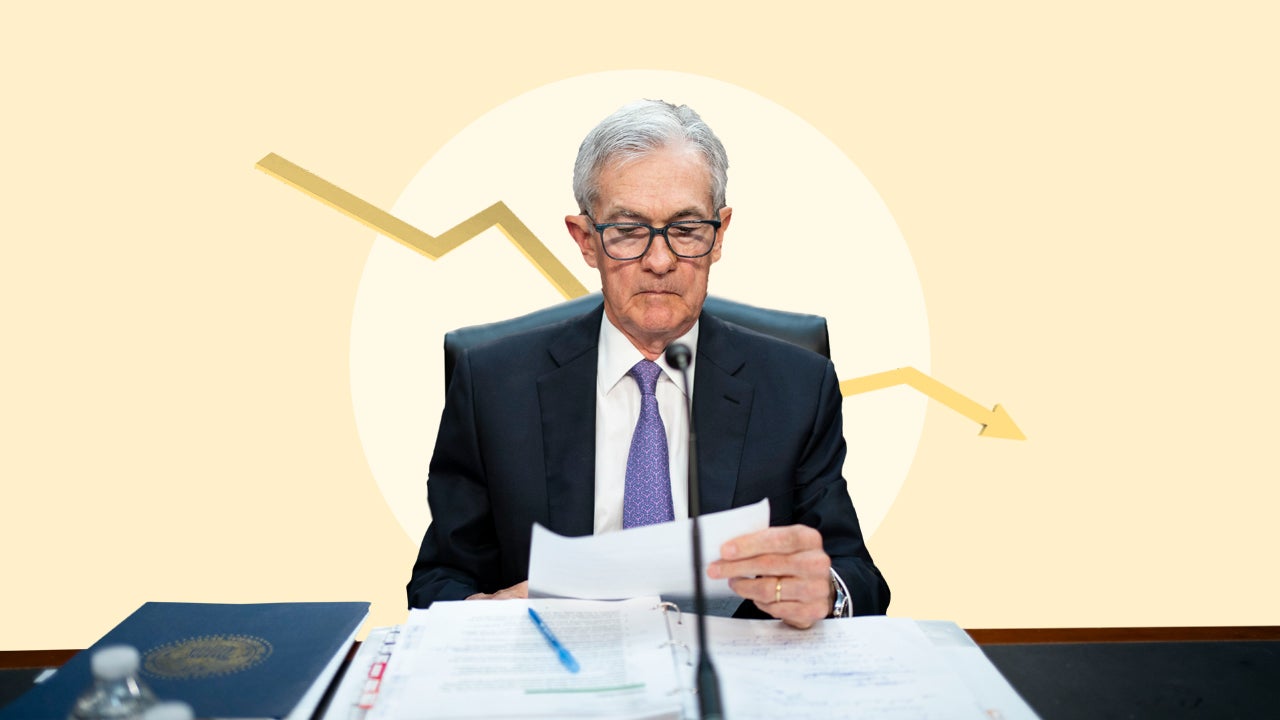Key takeaways
- The Fed is expected to leave interest rates at a 23-year high at its upcoming gathering but open the door to an interest rate cut by its next meeting in September.
- With the unemployment rate recently hitting a two-plus-year high, some economists are starting to think September might be too late to cut borrowing costs.
- The economy at a crossroad, consumers should focus on paying off high-interest debt and building an emergency fund.
The last worry on a firefighter’s mind as he extinguishes the blaze of a burning building is the potential for water damage. For the Federal Reserve, the same is often true as it battles inflation; there’s little room for concern about what it could mean for jobseekers.
Until those red-hot price pressures start to fizzle out.
For the first time since Fed officials were maintaining ultralow interest rates to help the economy heal from the pandemic, the U.S. central bank looks poised to begin setting monetary policy with the job market in mind — shifting away from its predominant focus on the pace of price increases.
Inflation, at least by the Fed’s preferred measure, is now only half a percentage point above its 2 percent target, after once reaching as high as 7.1 percent. It’s giving policymakers the cover they need to consider the collateral damage of the highest interest rates in 23 years. Occurring alongside cooling inflation is a rapidly rising unemployment rate, which has climbed to a more than two-year high in as little as three months.
“Elevated inflation is not the only risk we face,” Fed Chair Jerome Powell said in a pivotal July testimony to Congress. Cutting interest rates “too late or too little could unduly weaken economic activity and employment.”
To be sure, policymakers on the Federal Open Market Committee (FOMC) look poised to keep their key benchmark interest rate in its current target range of 5.25-5.5 percent at their July 30-31 rate-setting meeting. Yet, they’re widely expected to signal that they could cut rates at their next gathering in September, as concerns about a recession and a broader economic slowdown mount.
Here are the three biggest questions surrounding the Fed’s rate-cut plans and its July meeting, including what it could mean for your finances.
The risk of being behind in calibrating interest rates with the health of the economy is a lot worse when interest rates are on the way down than it is on the way up. The economy could deteriorate quickly, and if they’re behind the curve, by the time they get caught up, it’s already too late.
— Greg McBride, CFA , chief financial analyst for Bankrate
1. Why is the Fed waiting to cut interest rates?
Notably, a growing chorus of economists and former Fed officials are starting to wonder whether the Fed should cut interest rates now.
“I’ve changed my mind,” former New York Fed President Bill Dudley wrote in a Thursday column in Bloomberg. “The Fed should cut, preferably at next week’s policymaking meeting.”
They recognize why officials are waiting. As an institution, the Fed is guided by communication protocols as strict as the British Royal Family. Don’t act too quickly, or you’ll look panicked. Give markets plenty of time to process your plans, or you’ll risk volatility. Be data-dependent, or you could make the wrong policy move. That MO naturally chains Fed officials to moving slowly.
Some economists say the Fed might be inclined to keep interest rates higher for longer because it doesn’t want to repeat past mistakes. Three years ago, the Fed’s own forecasts assumed that price increases were only temporary, so the Fed kept rates too low for too long. This time, economists say, officials may want to wait to see more data before concluding that a rate cut is warranted.
Economists also believe the Fed likely isn’t startled about the unemployment rate just yet. The current unemployment rate of 4.1 percent is still below the Fed’s estimates of the “natural” rate of unemployment (4.2 percent) — a level that allows for everyone who wants a job to find one without exacerbating inflation.
Meanwhile, economists say unemployment has increased for some “good” reasons — namely, a growing labor supply, rather than rising layoffs or lackluster job growth. In 2023, the most Americans since the early 2000s joined the workforce, Bureau of Labor Statistics data shows.. Those new entrants often need some time to find the positions that work right for them, especially if they haven’t been working in a while.
And perhaps most important of all, experts say slowing down an overheated economy was the Fed’s goal.
“It’s not worrisome because it’s what the doctor ordered,” says Sal Guatieri, senior economist and director at BMO Capital markets, referring to the pick up in the unemployment rate. “The Fed needs more confidence to see what the true or underlying trend on inflation is and what the trend in the unemployment rate really is.”
The latest remarks on interest rates and the economy from Fed officials
The job is not done on inflation. We have more work to do there, but at the same time, we need to be mindful of where the labor market is, and we have seen considerable softening in the labor market.
— Jerome Powell, Federal Reserve Chairman
We are getting closer to the time when a cut in the policy rate is warranted. … The evidence is mounting that the first quarter inflation data may have been an aberration and that the effects of tighter monetary policy have corralled high inflation.
— Christopher Waller, Fed Governor
You only want to stay this restrictive for as long as you have to, and this doesn’t look like an overheating economy to me.
— Austan Goolsbee, Chicago Fed President
2. Could holding off on a rate cut until September be a mistake?
But if Fed officials know that the time to cut interest rates could be coming soon, other experts are starting to ask: Why wait?
Proponents of cutting interest rates now equate rising unemployment to a plane taking off on the runway. Once it starts gaining speed, it’s often hard to slow it back down. Higher unemployment makes households jittery; even those who remain employed may pull back on spending. A sharp drop in consumption forces businesses to delay investments or hiring, quickly becoming a dangerous, vicious cycle.
“The Fed should have more of a forward-looking perspective,” says Gregory Daco, chief economist at EY-Parthenon. “The Fed is data-dependent but some policymakers are data-point dependent. You have policymakers that essentially have missed some of the signals in terms of the direction of travel in the economy.”
Other signs are beginning to look worrisome. For instance, the number of Americans unemployed for 27 weeks or longer — those considered to be facing long-term joblessness — is now the highest since 2017.
For now, the calendar isn’t working in Fed officials’ favor. The Fed will announce its July rate decision just two days before a key Bureau of Labor Statistics report gives insight on whether the pick up in the unemployment rate is a blip — or a trend.
“If we get the jobs report two days after the Fed meeting and it’s bad, they could have some egg on their face,” McBride says. “If there was a compelling reason to think that there was more risk in waiting until September than acting now, being data dependent means you have to evolve as the data does.”
3. How much will the Fed cut interest rates?
Most of the attention has been on when the Fed will cut interest rates for the first time, an important moment simply for the regime shift it signals. Yet, the most consequential question for consumers may be how much the Fed cuts interest rates. If the Fed ends up cutting interest rates rapidly and aggressively, that might mean they’re worried about the economy rapidly deteriorating.
If the Fed does decide that it made a mistake by not cutting interest rates in July, it has two main options. First, it could cut interest rates by a more aggressive amount, such as half a percentage point instead of a quarter of a point.
Second, it could decide to cut borrowing costs at an emergency, unscheduled meeting. Fed officials haven’t shied away from aggressive moves like that before, but they reserve them for the more dire circumstances — when concerns about the economy trump the fear of looking panicked. Notably, the Fed in the late 1990s, an era that economists often compare the current tightening cycle to, featured an emergency rate cut, a Bankrate analysis of the Fed’s historic rate moves show.
Neither scenario is the consensus view. Guatieri’s forecast assumes the Fed will cut twice this year, in September and December, by quarter-point increments. He expects the Fed’s total rate cuts to total 2.25 percentage points, bringing the benchmark federal funds rate to a 3-3.25 percent target range. That’s still higher than it was at any point since the economy’s bounce back from the Great Recession of 2007-2009.
His forecast is even more aggressive than markets’ current expectations. By September 2025, rates are seen as holding in a 3.5-3.75 percent target range. Another gauge of interest rate expectations, the 2-year Treasury yield is currently at a decade-plus high of 4.37 percent, according to Treasury Department data. Economists in Bankrate’s First-Quarter Economic Indicator poll, meanwhile, projected that interest rates will remain at historic highs until the end of 2026.
Daco’s estimates also pencil in two rate cuts this year, with the fed funds rate holding around 4 percent by the time the easing cycle concludes. But that depends on whether the slowdown in the U.S. economy ends up being more pronounced.
“We’ve soft-landed,” Daco says. “The Fed should be thinking about recalibrating now, rather than waiting until we’re close to the edge of the runway.”
What the Fed’s next announcement means for you
Fed policy is at a critical inflection point. Officials’ next moves will decide the fate of the U.S. expansion and whether Americans can continue reaping the benefits of a stable economy.
- Shop around for the best rate: Borrowing costs are already starting to edge lower, now that it looks like the Fed is preparing to cut interest rates. The average 30-year fixed-rate mortgage recently fell below 7 percent for the first time since February, Bankrate’s weekly survey of lenders showed. Meanwhile, home equity loan rates hit 8.59 percent in the week that ended on July 24, after rising as high as 8.95 percent last fall.
- Keep chipping away at high-cost debt: Yet, barring a major economic slowdown, borrowing costs are unlikely to fall far enough and fast enough to give consumers with high-interest debt a “get-out-of-jail-free” card. Devise a plan to pay off your balance. If you have credit card debt, consider a balance-transfer card that has a special 0 percent annual percentage rate (APR) offer.
- Don’t miss your chance to lock in a high yield: Yields on savings accounts and certificates of deposit (CD) have also been on the decline. If the Fed gives a clearer signal that rate cuts are coming, that descent could pick up speed. If you have the funds to lock away, don’t miss your chance to secure the highest-yielding 2-year or 5-year CD in over a decade.
- Prepare for the unexpected: Falling yields still shouldn’t deter you from building an emergency fund. Better yet, savers can still likely find a competitive rate that beats inflation if they park their cash in a high-yield online bank. The top-yielding online bank is currently offering a 5.45 percent annual percentage yield (APY), Bankrate’s latest rankings show.
“Some day, we will go back to 0 percent interest rates because that’s the playbook that gets trotted out when we have a severe economic crisis, but it would take that severe economic consequence to get there,” McBride says. “Where we are right now is more about easing up on the brakes, so that the economy doesn’t come to a screeching halt. Interest rates aren’t going to fall far enough fast enough to bail you out of a bad situation.”
Read the full article here





